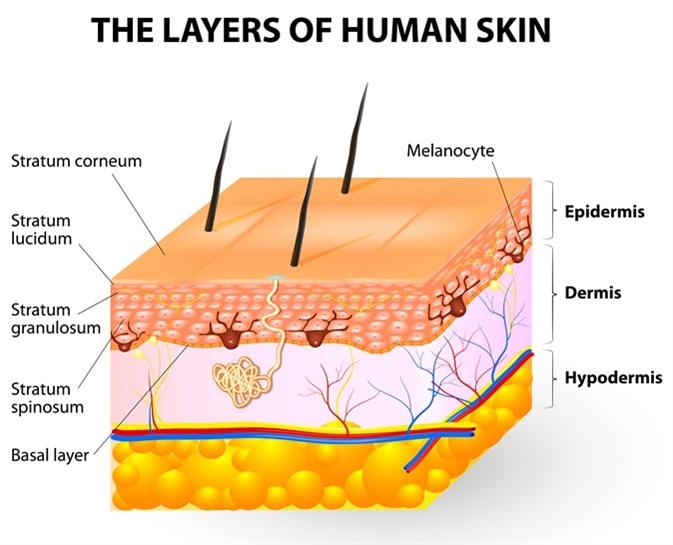A 30-year-old African American had surgery 6 months ago and the incision site is now raised, indurated, and shiny. This is most likely which type of tissue growth?
Melanoma
Keloid
Nevus
Angioma
The Correct Answer is B
A. Melanoma:
Melanoma is a type of skin cancer that arises from melanocytes, the cells that produce pigment (melanin) in the skin. Melanoma lesions are typically irregularly shaped, often asymmetrical, with varying shades of color (brown, black, tan, red, blue). They may have an uneven border and can evolve over time. Melanomas can be raised but are not typically described as indurated (firm) and shiny. They are also more commonly associated with changes in color, size, and shape.
B. Keloid:
A keloid is an abnormal overgrowth of scar tissue that extends beyond the boundaries of the original wound or incision site. Keloids are characterized by their raised appearance, firm or indurated texture, and shiny surface compared to the surrounding skin. They may also be darker than the surrounding skin due to increased collagen deposition. Keloids can develop months after an injury or surgery and are more common in individuals with darker skin tones, such as African Americans.
C. Nevus:
A nevus, commonly known as a mole or birthmark, is a benign growth of melanocytes or other skin cells. Nevus lesions can vary in appearance but are often flat or slightly raised, with a uniform color (brown, black, tan, or flesh-colored). They are usually not described as indurated or shiny. Nevus lesions can be present at birth (congenital nevus) or develop later in life (acquired nevus).
D. Angioma:
Angiomas are benign tumors that originate from blood vessels or lymphatic vessels. They can present as red or purplish raised lesions on the skin. Angiomas are typically not described as indurated or shiny. Common types of angiomas include cherry angiomas (small, red papules) and spider angiomas (red, spider-like lesions with central vessels).
Nursing Test Bank
Naxlex Comprehensive Predictor Exams
Related Questions
Correct Answer is A
Explanation
A. Colonization - replicating microorganisms: not yet Infected
This pairing is correct. Colonization refers to the presence and replication of microorganisms on the wound surface. At this stage, the wound is not yet infected, as there may be microorganisms present, but they have not caused an inflammatory response or tissue damage.
B. Systemic infection - Wound is darker than the surrounding skin with noted drainage present
This description does not match the stage of systemic infection. Systemic infection refers to an infection that has spread beyond the initial wound site, affecting the entire body systemically. The symptoms of systemic infection may include fever, increased heart rate, malaise, and altered mental status. The description provided seems more indicative of a local infection with drainage.
C. Contaminated - infection beyond the wound
This pairing is incorrect. Contaminated wounds refer to wounds with a high risk of infection due to the presence of foreign material or significant contamination. However, contamination does not necessarily mean that an infection has already developed beyond the wound. It signifies a risk of infection but does not define the infection stage itself.
D. Local infection - sepsis
This pairing is incorrect. A local infection is confined to the wound site and may present with symptoms such as erythema, warmth, swelling, pain, and purulent drainage. Sepsis, on the other hand, is a severe systemic response to infection, characterized by widespread inflammation and organ dysfunction. Sepsis is not synonymous with a local infection; it represents a more advanced and life-threatening stage of infection.
Correct Answer is B
Explanation
A. Loose connective tissue:
Melanocytes are not typically found in loose connective tissue. Their primary location is within the epidermis, specifically in the basal layer, where they interact with keratinocytes to produce melanin and contribute to skin color. Loose connective tissue contains collagen and elastin fibers, as well as fibroblasts, but it does not house melanocytes.
B. Epidermis:
This is the correct answer. Melanocytes are primarily located in the basal layer of the epidermis, which is the deepest layer of the epidermis. These cells produce melanin, a pigment that helps protect the skin from UV radiation and determines skin color. Melanocytes are interspersed among keratinocytes in the epidermis and transfer melanin to keratinocytes to provide skin pigmentation.
C. Dermis:
The dermis is the layer of skin beneath the epidermis and consists of connective tissue, blood vessels, nerves, hair follicles, and sweat glands. While the dermis plays a crucial role in supporting and nourishing the epidermis, melanocytes are not primarily located in the dermis. They are confined to the basal layer of the epidermis.
D. Superficial fascia:
The superficial fascia, also known as the subcutaneous tissue or hypodermis, lies beneath the dermis and consists of adipose (fat) tissue and connective tissue. It provides insulation, energy storage, and cushioning for underlying structures. However, melanocytes are not typically found in the superficial fascia. They are restricted to the epidermis, specifically the basal layer, where they carry out their function of melanin production.

Whether you are a student looking to ace your exams or a practicing nurse seeking to enhance your expertise , our nursing education contents will empower you with the confidence and competence to make a difference in the lives of patients and become a respected leader in the healthcare field.
Visit Naxlex, invest in your future and unlock endless possibilities with our unparalleled nursing education contents today
Report Wrong Answer on the Current Question
Do you disagree with the answer? If yes, what is your expected answer? Explain.
Kindly be descriptive with the issue you are facing.
